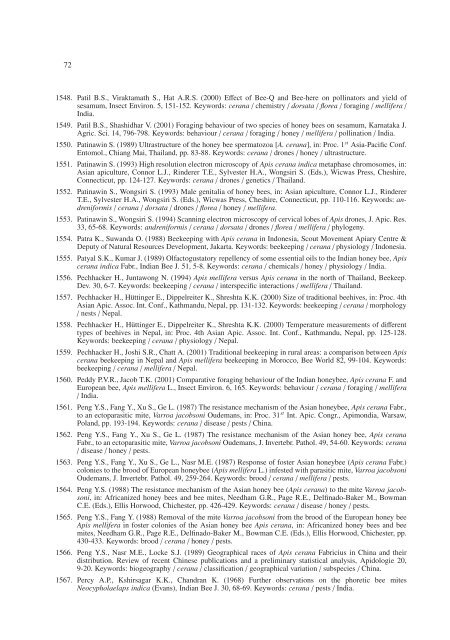Bibliography of Apis cerana Fabricius - Apidologie
Bibliography of Apis cerana Fabricius - Apidologie
Bibliography of Apis cerana Fabricius - Apidologie
You also want an ePaper? Increase the reach of your titles
YUMPU automatically turns print PDFs into web optimized ePapers that Google loves.
72<br />
1548. Patil B.S., Viraktamath S., Hat A.R.S. (2000) Effect <strong>of</strong> Bee-Q and Bee-here on pollinators and yield <strong>of</strong><br />
sesamum, Insect Environ. 5, 151-152. Keywords: <strong>cerana</strong> / chemistry / dorsata / florea / foraging / mellifera /<br />
India.<br />
1549. Patil B.S., Shashidhar V. (2001) Foraging behaviour <strong>of</strong> two species <strong>of</strong> honey bees on sesamum, Karnataka J.<br />
Agric. Sci. 14, 796-798. Keywords: behaviour / <strong>cerana</strong> / foraging / honey / mellifera / pollination / India.<br />
1550. Patinawin S. (1989) Ultrastructure <strong>of</strong> the honey bee spermatozoa [A. <strong>cerana</strong>], in: Proc. 1st Asia-Pacific Conf.<br />
Entomol., Chiang Mai, Thailand, pp. 83-88. Keywords: <strong>cerana</strong> / drones / honey / ultrastructure.<br />
1551. Patinawin S. (1993) High resolution electron microscopy <strong>of</strong> <strong>Apis</strong> <strong>cerana</strong> indica metaphase chromosomes, in:<br />
Asian apiculture, Connor L.J., Rinderer T.E., Sylvester H.A., Wongsiri S. (Eds.), Wicwas Press, Cheshire,<br />
Connecticut, pp. 124-127. Keywords: <strong>cerana</strong> / drones / genetics / Thailand.<br />
1552. Patinawin S., Wongsiri S. (1993) Male genitalia <strong>of</strong> honey bees, in: Asian apiculture, Connor L.J., Rinderer<br />
T.E., Sylvester H.A., Wongsiri S. (Eds.), Wicwas Press, Cheshire, Connecticut, pp. 110-116. Keywords: andreniformis<br />
/ <strong>cerana</strong> / dorsata / drones / florea / honey / mellifera.<br />
1553. Patinawin S., Wongsiri S. (1994) Scanning electron microscopy <strong>of</strong> cervical lobes <strong>of</strong> <strong>Apis</strong> drones, J. Apic. Res.<br />
33, 65-68. Keywords: andreniformis / <strong>cerana</strong> / dorsata / drones / florea / mellifera / phylogeny.<br />
1554. Patra K., Suwanda O. (1988) Beekeeping with <strong>Apis</strong> <strong>cerana</strong> in Indonesia, Scout Movement Apiary Centre &<br />
Deputy <strong>of</strong> Natural Resources Development, Jakarta. Keywords: beekeeping / <strong>cerana</strong> / physiology / Indonesia.<br />
1555. Patyal S.K., Kumar J. (1989) Olfactogustatory repellency <strong>of</strong> some essential oils to the Indian honey bee, <strong>Apis</strong><br />
<strong>cerana</strong> indica Fabr., Indian Bee J. 51, 5-8. Keywords: <strong>cerana</strong> / chemicals / honey / physiology / India.<br />
1556. Pechhacker H., Juntawong N. (1994) <strong>Apis</strong> mellifera versus <strong>Apis</strong> <strong>cerana</strong> in the north <strong>of</strong> Thailand, Beekeep.<br />
Dev. 30, 6-7. Keywords: beekeeping / <strong>cerana</strong> / interspecific interactions / mellifera / Thailand.<br />
1557. Pechhacker H., Hüttinger E., Dippelreiter K., Shreshta K.K. (2000) Size <strong>of</strong> traditional beehives, in: Proc. 4th<br />
Asian Apic. Assoc. Int. Conf., Kathmandu, Nepal, pp. 131-132. Keywords: beekeeping / <strong>cerana</strong> / morphology<br />
/ nests / Nepal.<br />
1558. Pechhacker H., Hüttinger E., Dippelreiter K., Shreshta K.K. (2000) Temperature measurements <strong>of</strong> different<br />
types <strong>of</strong> beehives in Nepal, in: Proc. 4th Asian Apic. Assoc. Int. Conf., Kathmandu, Nepal, pp. 125-128.<br />
Keywords: beekeeping / <strong>cerana</strong> / physiology / Nepal.<br />
1559. Pechhacker H., Joshi S.R., Chatt A. (2001) Traditional beekeeping in rural areas: a comparison between <strong>Apis</strong><br />
<strong>cerana</strong> beekeeping in Nepal and <strong>Apis</strong> mellifera beekeeping in Morocco, Bee World 82, 99-104. Keywords:<br />
beekeeping / <strong>cerana</strong> / mellifera / Nepal.<br />
1560. Peddy P.V.R., Jacob T.K. (2001) Comparative foraging behaviour <strong>of</strong> the Indian honeybee, <strong>Apis</strong> <strong>cerana</strong> F. and<br />
European bee, <strong>Apis</strong> mellifera L., Insect Environ. 6, 165. Keywords: behaviour / <strong>cerana</strong> / foraging / mellifera<br />
/ India.<br />
1561. Peng Y.S., Fang Y., Xu S., Ge L. (1987) The resistance mechanism <strong>of</strong> the Asian honeybee, <strong>Apis</strong> <strong>cerana</strong> Fabr.,<br />
to an ectoparasitic mite, Varroa jacobsoni Oudemans, in: Proc. 31st Int. Apic. Congr., Apimondia, Warsaw,<br />
Poland, pp. 193-194. Keywords: <strong>cerana</strong> / disease / pests / China.<br />
1562. Peng Y.S., Fang Y., Xu S., Ge L. (1987) The resistance mechanism <strong>of</strong> the Asian honey bee, <strong>Apis</strong> <strong>cerana</strong><br />
Fabr., to an ectoparasitic mite, Varroa jacobsoni Oudemans, J. Invertebr. Pathol. 49, 54-60. Keywords: <strong>cerana</strong><br />
/ disease / honey / pests.<br />
1563. Peng Y.S., Fang Y., Xu S., Ge L., Nasr M.E. (1987) Response <strong>of</strong> foster Asian honeybee (<strong>Apis</strong> <strong>cerana</strong> Fabr.)<br />
colonies to the brood <strong>of</strong> European honeybee (<strong>Apis</strong> mellifera L.) infested with parasitic mite, Varroa jacobsoni<br />
Oudemans, J. Invertebr. Pathol. 49, 259-264. Keywords: brood / <strong>cerana</strong> / mellifera / pests.<br />
1564. Peng Y.S. (1988) The resistance mechanism <strong>of</strong> the Asian honey bee (<strong>Apis</strong> <strong>cerana</strong>) to the mite Varroa jacobsoni,<br />
in: Africanized honey bees and bee mites, Needham G.R., Page R.E., Delfinado-Baker M., Bowman<br />
C.E. (Eds.), Ellis Horwood, Chichester, pp. 426-429. Keywords: <strong>cerana</strong> / disease / honey / pests.<br />
1565. Peng Y.S., Fang Y. (1988) Removal <strong>of</strong> the mite Varroa jacobsoni from the brood <strong>of</strong> the European honey bee<br />
<strong>Apis</strong> mellifera in foster colonies <strong>of</strong> the Asian honey bee <strong>Apis</strong> <strong>cerana</strong>, in: Africanized honey bees and bee<br />
mites, Needham G.R., Page R.E., Delfinado-Baker M., Bowman C.E. (Eds.), Ellis Horwood, Chichester, pp.<br />
430-433. Keywords: brood / <strong>cerana</strong> / honey / pests.<br />
1566. Peng Y.S., Nasr M.E., Locke S.J. (1989) Geographical races <strong>of</strong> <strong>Apis</strong> <strong>cerana</strong> <strong>Fabricius</strong> in China and their<br />
distribution. Review <strong>of</strong> recent Chinese publications and a preliminary statistical analysis, <strong>Apidologie</strong> 20,<br />
9-20. Keywords: biogeography / <strong>cerana</strong> / classification / geographical variation / subspecies / China.<br />
1567. Percy A.P., Kshirsagar K.K., Chandran K. (1968) Further observations on the phoretic bee mites<br />
Neocypholaelaps indica (Evans), Indian Bee J. 30, 68-69. Keywords: <strong>cerana</strong> / pests / India.




